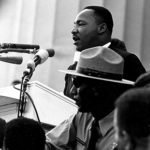When a Boy Died and a Georgia City Burned
When I began researching my novel, Cinnamon Girl, I had originally planned to begin with the riots which happened after the assassination of Dr. Martin Luther King, Jr. That event is seared into my memory.

I was in eighth grade and two years earlier my mother had married a man who taught high school chorus. I had met a couple of his students and liked them. In fact, one of them stayed with us for awhile after her parents kicked her out of the house for having a romantic relationship with another girl. Another of his students, Bee, was my “cool babysitter.” She was more like a friend than a babysitter, which helped since I considered myself too old to be babysat.
MLK Jr. wasn’t exactly on my radar. I was too busy negotiating the shoals of early adolescence to pay much attention to what was going on in the world at large. I knew about racism, of course. It was all around me, and as the daughter of a Connecticut Yankee living in Jacksonville, Florida, I was sometimes the object of derision among the kids who used the N-word freely and often. My mother fed me a steady diet of her much more enlightened views, and it did seem to help inoculate me from the prevailing hatred.
So when my babysitter/friend called to joyfully relay the news that Martin Luther King, Jr. had been shot, I turned and told my mom, whose expression conveyed a look of horror and disgust that I have never forgotten. That was the end of any relationship with Bee, who, it turned out, was not so “cool” after all.
But MLK’s assassination occurred in 1968, and my book takes place in 1970. My locale of choice for the first part of the book was Augusta, Georgia. I chose it because it was a small southern town that looked a like the part of town in Jacksonville where I’d grown up and because it had a river. I grew up a few blocks away from the St. John’s River and can’t imagine having a book without a river!
Conveniently for my story, but horribly for the people in 1970 Augusta, a “race riot” did occur in May of 1970. A Black teenager named Charles Oatman died as a result of injuries inflicted while he was in jail.
After I researched the story, I had one of my characters describe what happened: “Somebody burned him with cigarettes on his buttocks. Somebody burned him with cigarettes on his arms and legs and his back. They stabbed him with forks and lashed him across his back. And he was a little thing, not more than a hundred pounds soaking wet. Don’t know what he was doing in that jail with grown men.”
Black people in Augusta were incensed. Long before the Black Lives Matter movement, anger and frustration over this cruel and senseless death boiled over into the streets. The White community in Augusta had been paying lip service to equality and integration, but nothing was equal in this town where some Black neighborhoods lacked water and sewage.
The end result of the protests? From WV Public Broadcasting: “A protest-turned-riot over the brutal murder of a Black teenager left six Black men dead from police bullets. There was never justice for any of the deaths, including 16-year-old Charles Oatman, who died in the Richmond County Jail.”
![]()
Pictures and podcasts about the riot can be found here and here.
I was surprised during my research to find this article explaining how “Godfather of Soul” James Brown played a role in quelling tensions and bringing peace to the city.

One of the reasons I write historical fiction is because many of the issues we face today are not new. The riot in Augusta in 1970 is a perfect example of what happens when collective pain is shoved under the carpet. One can only hope that a historical perspective will remind us of what didn’t work in the past and enable us to see the problems of the present as an opportunity to make a different choice.
